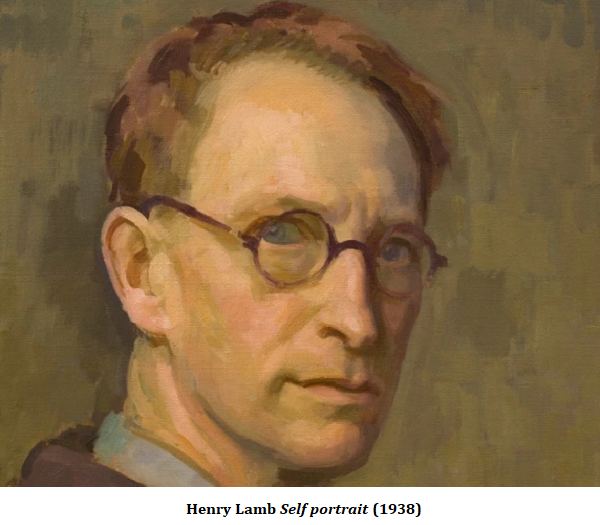
An exhibition mounted by Messums Gallery in England this northern spring, of works by Henry Lamb MC RA (1883–1960) provides an occasion to review and reconsider this most accomplished artist of the English Post-Impressionist school. He was born in Adelaide, but lived most of his life in England. His father was Sir Horace Lamb, who at the time was Professor of Mathematics at the University of Adelaide. The current Messums exhibition also recalls to mind memories of the artist’s second wife Lady Pansy Lamb (nee Pakenham) (1904–1999) who was the model for some of his most effective portrait works. The Lambs were part of that very interesting world spanning late Edwardian times and the “Bright Young Things” of the 1920s. Indeed, Pansy Lamb was a key witness in Evelyn Waugh’s long-drawn-out marriage annulment proceedings from 1933 to 1936.
This essay appears in the latest Quadrant.
Click here to subscribe
Henry Lamb was of the generation of painters, coming after James McNeill Whistler, which had trained under the eminent Augustus John and Sir William Orpen, with whose respective styles Lamb’s pictures often had some similarities. Lamb’s oeuvre is an enormously satisfying body of work, as can be readily seen from the internet, across both portraits and landscape.
Henry Lamb moved from Australia to England with his family in about 1885. He at first pursued medical studies at Owens College in Manchester, which he abandoned at the age of twenty-two, in favour of studying art in London under John and Orpen at their short-lived Chelsea Art School. He married Nina Forrest (nicknamed “Euphemia”) in 1906, but the marriage failed.
It was Augustus John who had the strongest formative influence upon Lamb, who accompanied John to work in Paris at the Academie de la Palette and later on the coast of Brittany. Soon after that, Lamb 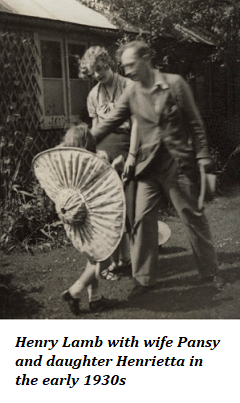 travelled to Gola Island in Ireland, again seeking, as he had in Brittany, that measure of the traditional life which survived in such places longer than elsewhere, even though it was disappearing fast as the twentieth century wore on, unto its hideous highlights in the two world wars.
travelled to Gola Island in Ireland, again seeking, as he had in Brittany, that measure of the traditional life which survived in such places longer than elsewhere, even though it was disappearing fast as the twentieth century wore on, unto its hideous highlights in the two world wars.
On turning to London, Lamb at first became part of the so-called Fitzroy Group of artists and then helped found the Camden Town Group and the London Group. He also had links with the Bloomsbury Group, with some of whose members he was on friendly terms, although he was certainly not immersed in Bloomsbury. Lamb knew Vanessa Stephen and Clive Bell from his earlier London days. It has been said that Lamb was often disdainful of the Bloomsberries, yet his celebrated portrait of his friend Lytton Strachey, painted between 1912 and 1914, is one of those signature or signal works of the then new century. Indeed, Lamb’s portrayal of the languorous Strachey, now famed in the Tate Gallery, was described by Sir John Rothenstein as “one of the best portraits painted in England this century”. The Messums catalogue recounts the important points that “Lamb’s early work was influenced by Gauguin and his paintings were included in the second Post-Impressionist Exhibition held at the Grafton Galleries London in 1913.”[1] John and Lamb became regarded as leading British artists.
In 1914, when the First World War broke out, Lamb returned to medical studies and he served with the  Royal Army Medical Corps in France, in Salonika and then in Palestine. Although Lamb was not appointed as an official war artist, he made many sketches and studies in France, on the Macedonian front and in Palestine. After the war, he painted large-scale works from such sketches, including Irish Troops in the Judaean Hills, now in the Imperial War Museum, and the remarkable Advanced Dressing Station on the Struma (1916) which is part of the collection of the Manchester City Art Gallery. The Messums catalogue takes up the story thus:
Royal Army Medical Corps in France, in Salonika and then in Palestine. Although Lamb was not appointed as an official war artist, he made many sketches and studies in France, on the Macedonian front and in Palestine. After the war, he painted large-scale works from such sketches, including Irish Troops in the Judaean Hills, now in the Imperial War Museum, and the remarkable Advanced Dressing Station on the Struma (1916) which is part of the collection of the Manchester City Art Gallery. The Messums catalogue takes up the story thus:
Lamb received the Military Cross for bravery under fire in the Judaean Hills during the First World War. It was an experience that became an inspiration, translated into one of his most striking paintings [the Irish Troops picture] … like John Nash he was able to draw on his memories to depict the scene in all its ear-ringing dissonance and death. However, it was in the last months of that terrible war, posted to the trenches of France, that he succumbed to a gas attack and was invalided home.
Some of Lamb’s best pencil drawings are small but compelling sketches of French soldiers and nurses, seen at the Troop Movement Station and Military Hospital at Fecamp in Normandy.
Afterwards, Lamb moved to the English countryside and married Lady Pansy Pakenham. Those developments and an impending family, were to mark the happy culmination of [Lamb’s] recuperation period and the start of a new direction for his career. Henry Lamb arrived at the quiet village of Coombe Bissett in the summer of 1928 soon after marrying Lady Pansy and they would remain there for the rest of their [joint] lives. In senses both temporal and spiritual, Lamb had found Arcadia in this corner of England. By this time, Lamb had settled into a style of painting more completely his own, though his approach was never formulaic.
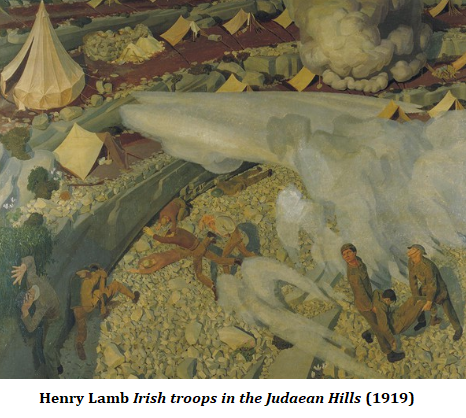
The Messums exhibition of 2021, with its small collection of paintings shows a perpetually curious artist, continually playing with form, composition and subject. He painted Pansy and their children endlessly, as well as the village and villagers, the river and surrounding countryside, and occasional still lives. Alongside he undertook a number of important portraits of notable figures in politics, academia and art during this time. Lamb would paint in a barn-like studio at the end of the house, bordering the garden sloping down to the River Ebble. It was an idyllic setting, their children playing in the shallow waters of the Ebble and beyond rising downland, uncultivated pastures and chalkland wildflowers.”
It was at this happy time that John Betjeman wrote the pleasing verse which has immortalised Lady Pansy:
O the calm of Coombe Bissett is tranquil and deep
Where Ebble flows soft in her downland asleep;
And beauty to me came a-pushing a pram,
In the shape of sweet Pansy Felicia Lamb.
So taken with their home at Coombe Bissett and its surrounds was Lamb, that soon after they were established there, he painted a portrait of himself and Lady Pansy which is what Messums have described as “a grand and playful take on Gainsborough’s Mr and Mrs Andrews … where Henry and Pansy stand with quiet pride over the small corner of the English countryside bordering their home”. This double portrait features as the Messums catalogue cover (below).

During the Second World War, Henry Lamb was appointed an official war artist and some of his sketches and watercolours, notably one of Winston Churchill in conference with other wartime military leaders (below) in the Messums exhibition, dated from the initial period where Lamb sought to memorialise the War Cabinet. He later turned to portrayals of military servicepeople seen in the south of England. At about this time, Lamb was elected as an associate to the Royal Academy and was made a trustee of not only the National Gallery, but also a trustee of the Tate Gallery as well. These appointments reflected Lamb’s high painterly training and achievements as an artist in the national life of the United Kingdom. He was elected to his full membership of the Royal Academy in 1949.
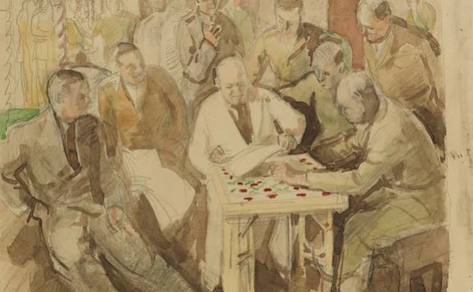
An idea of the scope and range of Lamb’s works can be gleaned from even the relatively small collection of works in the exhibition mounted by Messums, who represent the Henry Lamb estate. The works are drawn from the inter-war years, which were so important for Lamb’s development as a painter. They include: The Artist and His Wife (1930) as mentioned earlier; Study for the Artist’s Wife; The Artist’s Wife and her daughter Henrietta (1930); The Infant (1933); Girl with Rose (1943); Still Life with Apples (1929); Flowers in a Jug (1934); Bathers (1930s); The Kenyon Family (1940s); The Behrend Family (1927); Mollie Courtauld (1920s); and Bivouac (1923). Lamb’s drawings shown in the exhibition include Portrait of a Nurse, Fecamp (1915); Man Reading, Fecamp (1915) and the watercolours include Churchill and Allies (early 1940s) and Pay at the Canadian Armoured Division (early 1940s), with various others. One of the finest works in the exhibition is the portrait of Mollie Courtauld, wife of Augustine Courtauld, from the founding family of the Courtauld Institute of Art in London. After his death, she married Rab Butler, the Conservative Home Secretary and later Foreign Secretary. Lamb’s portrait of her in oils is a delight. During the inter-war years, Lamb was kept very busy indeed visiting country estates and university towns, doing portrait commissions. Evelyn Waugh, Cecil Beaton and Anthony Powell are among some of the better known of his sitters.
The Messums catalogue features four telling photographs of Henry Lamb at major stages of his life: the first in uniform with his Sam Browne belt and badges as a Medical Corps officer; the next of Lamb and Lady Pansy with their children Henrietta, Felicia and Valentine in 1939; then Lamb pictured in his studio in the inter-war years with his daughters Henrietta and Felicia; and lastly an endearing late photograph, probably taken in the 1950s, of Lamb seated nonchalantly at his studio desk, wearing carpet slippers and a chequered jacket.
 A further word here, based on the delightful experience of meeting with Lady Pansy Lamb at Rome twice during the 1990s. Lady Pansy had converted to Catholicism, and after Henry Lamb’s death she moved in 1981 to a small flat in central Rome, where she served the Fabbrica of St Peter’s Basilica in the humble capacity of a tourist guide, occupying a wooden desk just inside the portico of St Peter’s and dispensing advice and guidance to English-speaking tourists visiting the Vatican City. She did so in a most engaging way and still retained her distinctive speaking voice, so redolent of the 1930s, with just a slight lisp in pronouncing the letter “r”. Lady Pansy also developed a deep personal devotion to the charism of the then Pontiff and now Saint, John-Paul II.
A further word here, based on the delightful experience of meeting with Lady Pansy Lamb at Rome twice during the 1990s. Lady Pansy had converted to Catholicism, and after Henry Lamb’s death she moved in 1981 to a small flat in central Rome, where she served the Fabbrica of St Peter’s Basilica in the humble capacity of a tourist guide, occupying a wooden desk just inside the portico of St Peter’s and dispensing advice and guidance to English-speaking tourists visiting the Vatican City. She did so in a most engaging way and still retained her distinctive speaking voice, so redolent of the 1930s, with just a slight lisp in pronouncing the letter “r”. Lady Pansy also developed a deep personal devotion to the charism of the then Pontiff and now Saint, John-Paul II.
Country Life magazine featured Lady Pansy Lamb with a more than cameo appearance all of her own, in the magazine’s “Living National Treasure” series. The accompanying photograph showed a sprightly and indeed, wiry lady of over ninety years, but still with the traces in her distinguished features of the great beauty she was in the 1920s and was celebrated in that verse by John Betjeman.
Pansy Lamb was thus a notable and special survival from those inter-war years. She was also a published writer and as the spouse of her remarkable husband Henry she saw and represented much of a vanished age in which indeed, a place like Coombe Bissett in Wiltshire could seem like unto an Arcadia. Lady Pansy’s father, the Fifth Earl of Longford, was killed on active service at Gallipoli. Henry Lamb with his wartime experiences and especially his service in the Great War, had also seen the spectre of Death, who appears, as the classical line goes, Et in Arcadia Ego. In Lamb’s case, the effect was not so much shattering as a lifelong encouragement thereafter to produce works of beauty and enduring value. Lady Pansy was a friend of Evelyn Waugh and of his first wife Evelyn Gardner. Indeed, it seems Pansy introduced them and at first encouraged the marriage, but that escapade proved to be a disastrous mesalliance. Pansy and Evelyn Gardner had shared a flat whilst working in London in the 1920s. Waugh’s novelist brother Alec Waugh described them as “more than usually pleasant examples of the Modern Girl, emancipated but not brassy”. Evelyn Gardner turned out brassy, Pansy (below) not.
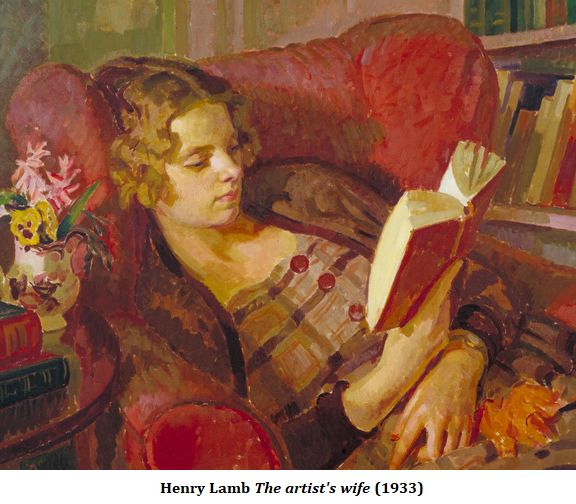
Nor was Lady Pansy very especially enamoured of the world of the 1920s as Waugh depicted it in his telling and highly romantic novel Brideshead Revisited. She wrote to Waugh in 1945 when the book first came out, in the following terms:
You cannot make me nostalgic about the world I knew in the 1920s. And yet it was the same world that you describe, or at any rate impinged on it. I was a debutante in 1922 and though neither smart nor rich, went to three dances in historic houses … it all seems very dull. You see English Society of the 20s as something baroque and magnificent on its last legs … I fled from it because it seemed prosperous, bourgeois and practical and I believe it still is.
It is worth noting that even Waugh himself later came to see the point of this; even though it does not at all detract from the value of his best-known work.
Henry Lamb’s life and work will be of special interest to readers in South Australia, where the State Gallery at Adelaide has in its impressive collection at least five of his works as well as work by Augustus John, amongst other British Post-Impressionists. Lamb was a painter of the front rank and was in the inter-war period widely regarded as such, along with John.
The memory of the Australian-born painter Henry Lamb and his English wife Lady Pansy is something to be treasured in a world which is now at a distance of nearly a century from the time when they were newly married, an epoch so very far removed from today’s world, in which painterliness and poetry are now at a great discount, due to unfortunate changes in mores and in the arts. Abilities like those of Lamb and John are now scoffed at by fashionable bien-pensants, most of whom could not wield a paintbrush with any success, even if they deigned to try to do it. The times are indeed out of joint and the widespread decline in the plastic arts is a lamentable prospect to look out upon, save for some pockets of survival here and there in some traditional academies found in Florence and in Russia, where, despite the horrific decades of the Soviets, orthodox painting schools flourished. It is a telling comment that what happened to art in the West in the twentieth century was such a negation of traditional skills and craft in painting, that only of recent years has the inevitable reaction and a return to tradition begun to be seen.
Lamb, as a key figure in British Post-Impressionism, is well represented by works in the collections of public galleries in the United Kingdom, the United States of America, in Canada and Australia and in other Commonwealth countries.
Dr Douglas Hassall, a frequent contributor on art, lives in Canberra
[1] Messums Gallery Henry Lamb MC RA (1883-1960) “IN ARCADIA: Paintings from the interwar years from the Henry Lamb Estate.” Messums Wiltshire, London & Yorkshire 2021 and used extensively for this article.
 Sign In
Sign In 0 Items (
0 Items ( Search
Search










Yes, the pursuit of the beautiful, the good, and the truth of the essential ingredients of human flourishing in visual art, prose, poetry, and theatre is scarcely seen today.
I saw somewhere that the use of the arts to encourage people to engage in proper human development -in psychological, perhaps spiritual terms- went into fast decline soon after the eighth of June, 1820.
Pity really. But what’s done is done.
Many thanks for bringing this artist to our attention. Art history is so obsessed with the worship of rebellious ‘originality’ that work of this high quality can get passed by.
A good story well told. I know Lamb’s portrait of Anthony Powell but hadn’t realised they were brothers-in-law.